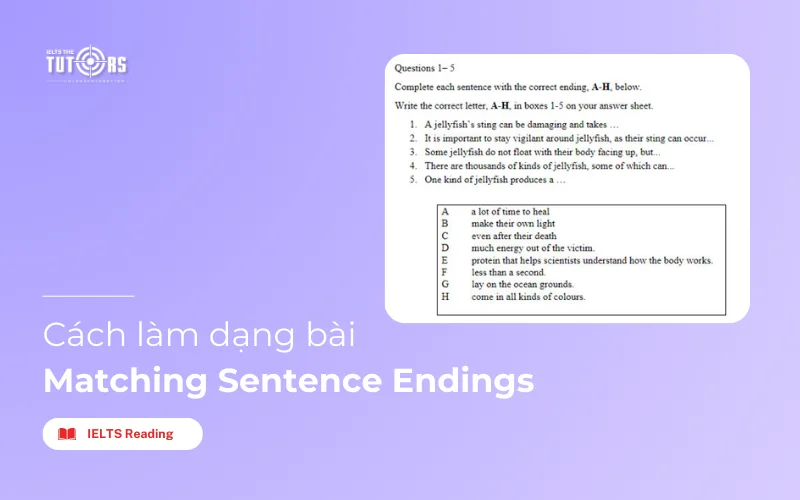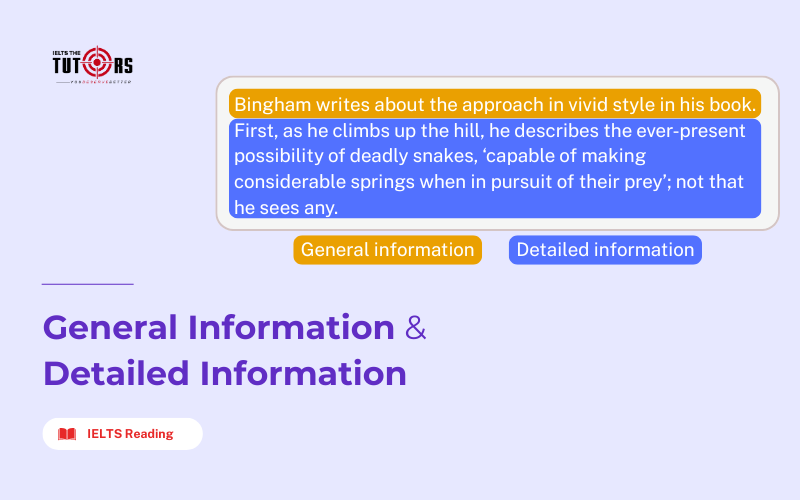
Matching Sentence Endings là gì?
Matching Sentence Endings thường ít xuất hiện hơn các dạng bài khác trong IELTS Reading, tuy nhiên đây cũng là một dạng bài khá hay mà bạn vẫn cần nắm chắc kiến thức và cách làm. Điều này không chỉ giúp bạn tránh mất điểm không đáng có mà còn tích lũy thêm kinh nghiệm để tiến bộ hơn.
Vậy, hãy cùng khám phá chi tiết cách làm dạng bài IELTS Reading Matching Sentence Endings ngay trong bài viết này nhé!
| Key takeaways |
| Định nghĩa: Matching Sentence Endings trong IELTS Reading yêu cầu hoàn thành câu bằng cách nối 2 vế của chúng lại với nhau.
Các bước làm bài:
|
Tổng quan dạng bài Matching Sentence Endings
Matching Sentence Endings sẽ cung cấp cho bạn danh sách các câu chưa hoàn chỉnh và danh sách các câu nửa sau của chúng (ending). Nhiệm vụ của thí sinh là nối những câu chưa hoàn chỉnh đó lại với nhau dựa vào nội dung bài đọc. Mục tiêu của dạng bài này là để kiểm tra kỹ năng liên kết câu của bạn theo ý chính của bài.
Dưới đây là format đề thi mẫu Matching Sentence Endings:

Cách làm Matching Sentence Endings
Dưới đây là các bước làm bài Matching Sentence Endings hiệu quả, hãy cùng phân tích ví dụ sau để hiểu rõ hơn nhé:
Jurassic crocodile discovery sheds light on reptiles' family tree
A. A newly identified species of 150 million-year-old marine crocodile has given insights into how a group of ancient animals evolved.
The ancestor of today's crocodiles belonged to a group of animals that developed a tail fin and paddle-like limbs for life in the sea, resembling dolphins more than crocodiles. These slender animals, which fed on fast-moving prey such as squid and small fish, lived during the Jurassic era in shallow seas and lagoons in what is now Germany. Related species have previously been found in Mexico and Argentina.
B. An international team of scientists, including researchers from Germany and the University of Edinburgh, identified the new species from a remarkably well-preserved skeleton. The fossil was discovered in 2014 in a quarry near the town of Bamberg in Bavaria, Germany by a team from the Naturkunde-Museum Bamberg, where it is now housed. The species, Cricosaurus bambergensis, takes its name from the town.
C. Researchers compared the fossil with those from other museum collections, and confirmed that it was a previously unseen species. The skeleton has several distinguishing features in its jaws, the roof of its mouth and tail, some of which have not been seen in any other species. Experts created digital images of the fossil in high resolution, to enable further research. They expect the fossil will aid greater understanding of a wider family of ancient animals, known as metriorhynchid, to which this species belonged.
D. Dr Mark Young, of the University of Edinburgh's School of GeoSciences, who took part in the study, said: “The rock formations of southern Germany continue to give us fresh insights into the age of dinosaurs. These rock layers were deposited at a time when Europe was covered by a shallow sea, with countries such as Germany and the UK being a collection of islands.”
E. Sven Sachs, from the Naturkunde-Museum Bielefeld, who led the project, said: “The study reveals peculiar features at the palate that have not been described in any fossil crocodile so far. There are two depressions which are separated by a pronounced bar. It is not clear what these depressions were good for.”

Questions 1- 4
Complete each sentence with the correct ending, A-G, below.
Write the correct letter, A-G, in boxes 1-4 on your answer sheet.
1. The ancient species of crocodile ate marine creatures that
2. The skeleton is kept in
3. Bones of the early type of crocodile
4. The geology of southern Germany
| 1. is believed to have lived 150 million years ago.
2. show some unique features. 3. resembled dolphins. 4. was laid down when the area was under water. 5. a museum in the town near where it was found. 6. swam fast through the water. 7. the University of Edinburgh's School of GeoSciences. |
(Nguồn: University of Edinburgh (April 4, 2019))
Bước 1: Đọc kỹ đề bài và xác định từ khóa
Hãy đọc kỹ danh sách các cụm Matching Endings để nhanh chóng xác định thông tin quan trọng. Trong bước này, bạn không cần phải chú ý đến danh sách các Endings, mà chỉ cần tập trung vào nửa câu đầu tiên và gạch chân những từ khóa thiết yếu.
1. The ancient species of crocodile ate marine creatures that
2. The skeleton is kept in
3. Bones of the early type of crocodile
4. The geology of southern Germany
Bước 2: Đọc văn bản và xác định các thông tin quan trọng
Hãy đọc lướt toàn bộ văn bản bằng cách áp dụng các phương pháp skimming và scanning. Sau đó xác định những thông tin có chứa từ khóa liên quan đến câu hỏi. Thông thường, các từ khóa trong bài đọc sẽ được thay thế bằng những từ đồng nghĩa trong đề bài (paraphrase).
1. The ancestor of today’s crocodiles belonged to a group of animals that developed a tail fin and paddle-like limbs for life in the sea, resembling dolphins more than crocodiles. These slender animals, which fed on fast-moving preys such as squid and small fish, lived during the Jurassic era in shallow seas and lagoons in what is now Germany
2. An international team of scientists, including researchers from Germany and the University of Edinburgh, identified the new species from a remarkably well-preserved skeleton. The fossil was discovered in 2014 in a quarry near the town of Bamberg in Bavaria, Germany by a team from the Naturkunde-Museum Bamberg, where it is now housed.
3. Researchers compared the fossil with those from other museum collections, and confirmed that it was a previously unseen species. The skeleton has several distinguishing features in its jaws, the roof of its mouth and tail, some of which have not been seen in any other species.
4. Dr Mark Young, of the University of Edinburgh's School of GeoSciences, who took part in the study, said: “The rock formations of southern Germany continue to give us fresh insights into the age of dinosaurs. These rock layers were deposited at a time when Europe was covered by a shallow sea, with countries such as Germany and the UK being a collection of islands.”
Xem thêm:
Bước 3: So sánh thông tin trong endings và nối các câu với nhau
Sau khi bạn đã đọc hiểu và xác định được nội dung của câu trong văn bản, hãy so sánh nó với các endings trong câu hỏi và xác định các phần tương ứng.
Nhớ kiểm tra kỹ các endings phù hợp đối với sự chính xác về mặt ngữ pháp và điền vào phiếu trả lời của bạn.
1. F: swam fast through the water
* ate = fed on
* swam fast through the water = fast-moving preys
2. E: a museum in the town near where it was found
* kept in = where it is now housed
* a museum in the town near where it was found = in a quarry near the town of Bamberg in Bavaria
3. B: show some unique features
* bones = the fossil
* distinguishing features = unique features
4. D: was laid down when the area was underwater
* geology = rock formations
* underwater = covered by a shallow sea
Các lỗi sai thường gặp phải khi làm Matching Sentence Endings
- Nhiều thí sinh chỉ dựa vào nghĩa và ngữ pháp của các câu hỏi để nối chúng lại với nhau mà không đọc bài đọc. Cách làm này rất không chính xác, mục tiêu của dạng bài này là để đánh giá mức độ đọc hiểu bài đọc của bạn hơn là kiểm tra cách các bạn nối các vế câu hỏi như thế nào.
- Nhiều trường hợp thí sinh đã xác định được vị trí của thông tin rồi nhưng lại đọc không kỹ hoặc chỉ chú ý đến từ khóa, dẫn đến việc so sánh thông tin với danh sách endings trở nên khó khăn.
- Chỉ tập trung tìm kiếm từ khóa trong bài đọc trùng khớp chính xác với danh sách nửa câu đầu tiên. Tuy nhiên, đa phần thông tin trong các bài thi IELTS luôn được paraphrase trước đó bằng nhiều cách.

Các lỗi sai thường gặp khi làm IELTS Reading Matching Sentence Endings
Một số tips hay khi làm bài
- Thứ tự đáp án trong bài đọc thường tương ứng với thứ tự các câu hỏi, vì vậy bạn nên bắt đầu từ câu hỏi 1 để xác định điểm khởi đầu cho việc tìm kiếm, với câu trả lời cho câu hỏi 2 sẽ nằm ngay sau câu trả lời cho câu hỏi 1 và tiếp tục tương tự.
- Hãy ưu tiên tập trung vào danh sách nửa câu đầu trước khi xem xét các endings hoặc nội dung của bài đọc, vì số lượng endings thường nhiều hơn danh sách câu hỏi dẫn đến việc đọc chi tiết tất cả sẽ tốn thời gian.
- Cố gắng dự đoán endings của mỗi nửa câu đầu trước khi xem qua các lựa chọn đáp án, điều này sẽ giúp bạn định hướng tư duy và loại trừ những đáp án không phù hợp.
- Khi làm bài, hãy suy nghĩ đến các từ đồng nghĩa và cách paraphrase khác mà người ra đề có thể sử dụng thay vì chỉ lặp lại chính xác từ trong câu hỏi, vì họ thường cố tình thay đổi cách diễn đạt để kiểm tra khả năng hiểu ngữ cảnh của bạn.
- Khi khoanh vùng từ khóa, hãy chú ý đến các danh từ riêng, bao gồm tên địa điểm và ngày tháng, vì chúng thường dễ dàng tìm thấy trong bài đọc.
- Đảm bảo rằng không chỉ các từ mà cả nghĩa của câu cũng khớp với nội dung bài đọc, nghĩa là phải nối các câu hoàn chỉnh một cách hợp lý.
- Cuối cùng, hãy quản lý thời gian một cách hợp lý bằng cách dành nhiều thời gian hơn cho câu hỏi đầu tiên, vì đây thường là câu khó nhất với nhiều lựa chọn, trong khi các câu hỏi sau thường có ít lựa chọn hơn và sẽ tốn ít thời gian hơn để hoàn thành.
Xem thêm: Tổng hợp những cách cải thiện kỹ năng Reading IELTS hiệu quả
Bài tập vận dụng
Book review on Musiccophilla
Norman M. Weinberger reviews the latest work of Oliver Sacks.
A. Music and the brain are both endlessly fascinating subjects, and as a neuroscientist specialising in auditory learning and memory, I find them especially intriguing. So I had high expectations of Musicophilia, the latest offering from neurologist and prolific author Oliver Sacks. And I confess to feeling a little guilty reporting that my reactions to the book are mixed.
B. Sacks himself is the best part of Musicophilia. He richly documents his own life in the book and reveals highly personal experiences. The photograph of him on the cover of the book- which shows him wearing headphones, eyes closed, clearly enchanted as he listens to Alfred Brendel perform Beethoven's Pathetique Sonata-makes a positive impression that is home out by the contents of the book. Sacks's voice throughout is steady and erudite but never pontifical. He is neither self-conscious nor self-promoting.
C. The preface gives a good idea of what the book will deliver. In it Sacks explains that he wants to convey the insights gleaned from the “enormous and rapidly growing body of work on the neural underpinnings of musical perception and imagery, and the complex and often bizarre disorders to which these are prone.” He also stresses the importance of “the simple art of observation” and “the richness of the human context.” He wants to combine “observation and description with the latest in technology,” he says, and to imaginatively enter into the experience of his patients and subjects. The reader can see that Sacks, who has been practicing neurology for 40 years, is tom between the old-fashioned path o observation and the new fangled, high-tech approach: He knows that he needs to take heed of the latter, but his heart lies with the former.
D. The book consists mainly of detailed descriptions of cases, most of them involving patients whom Sacks has seen in his practice. Brief discussions of contemporary neuroscientific reports are sprinkled liberally throughout the text. Part, “Haunted by Music,” begins with the strange case of Tony Cicoria, a nonmusical, middle-aged surgeon who was consumed by a love of music after being hit by lightning. He suddenly began to crave listening to piano music, which he had never cared for in the past. He started to play the piano and then to compose music, which arose spontaneously in his mind in a “torrent” of notes. How could this happen? Was the cause psychological? (He had had a near-death experience when the lightning struck him.) Or was it the direct result of a change in the auditory regions of his cerebral cortex? Electroencephalography (EEG) showed his brain waves to be normal in the mid-1990s, just after his, trauma and subsequent “conversion” to music. There are now more sensitive tests, but Cicoria, has declined to undergo them; he does not want to delve into the causes of his musicality. What a shame!
E. Part II, “A Range of Musicality,” covers a wider variety of topics, but unfortunately, some of the chapters offer little or nothing that is new. For example, chapter 13, which is five pages long, merely notes that the blind often have better hearing than the sighted. The most interesting chapters are those that present the strangest cases. Chapter 8 is about “amusia,” an inability to hear sounds as music, and “dysharmonia,” a highly specific impairment of the ability to hear harmony, with the ability to understand melody left intact. Such specific “dissociations” are found throughout the cases Sacks recounts.
F. To Sacks's credit, part III, “Memory, Movement and Music,” brings us into the underappreciated realm of music therapy. Chapter 16 explains how “melodic intonation therapy” is being used to help expressive aphasic patients (those unable to express their thoughts verbally following a stroke or other cerebral incident) once again become capable of fluent speech. In chapter 20, Sacks demonstrates the near- miraculous power of music to animate Parkinson's patients and other people with severe movement disorders, even those who are frozen into odd postures. Scientists cannot yet explain how music achieves this effect.
G. To readers who are unfamiliar with neuroscience and music behavior, Musicophilia may be something of a revelation. But the book will not satisfy those seeking the causes and implications of the phenomena Sacks describes. For one thing. Sacks appears to be more at ease discussing patients than discussing experiments. And he tends to be rather uncritical in accepting scientific findings and theories.
H. It's true that the causes of music-brain oddities remain poorly understood. However, Sacks could have done more to draw out some of the implications of the careful observations that he and other neurologists have made and of the treatments that have been successful. For example, he might have noted that the many specific dissociations among components of music comprehension, such as loss of the ability to perceive harmony but not melody, indicate that there is no music center in the brain. Because many people who read the book are likely to believe in the brain localisation of all mental functions, this was a missed educational opportunity.
I. Another conclusion one could draw is that there seem to be no “cures” for neurological problems involving music. A drug can alleviate a symptom in one patient and aggravate it in another, or can have both positive and negative effects in the same patient. Treatments mentioned seem to be almost exclusively antiepileptic medications, which “damp down” the excitability of the brain in general; their effectiveness varies widely.
J. Finally, in many of the cases described here the patient with music-brain symptoms is reported to have “normal” EEG results. Although Sacks recognises the existence of new technologies, among them far more sensitive ways to analyze brain waves than the standard neurological EEG test, he does not call for their use. In fact, although he exhibits the greatest compassion for patients, he conveys no sense of urgency about the pursuit of new avenues in the diagnosis and treatment of music-brain disorders. This absence echoes the book's preface, in which Sacks expresses fear that “the simple art of observation may be lost” if we rely too much on new technologies. He does call for both approaches, though, and we can only hope that the neurological community will respond.
Questions 37 – 40
Complete each sentence with the correct ending, A-F, below.
Write correct letter, A-F, in boxes 37-40 on your answer sheet
37. The content covered dissociations in understanding between harmony and melody.
38. The study of treating musical disorders.
39. The EEG scans of Sacks's patients.
40. Sacks believes testing based on new technologies.
List of endings:
A. show no music-brain disorders.
B. indicates that medication can have varied results,
C. is key for the neurological community to unravel the mysteries.
D. should not be used in Isolation.
E. indicate that not everyone can receive good education.
F. show a misconception that there is function centre localized in the brain
Answer Keys:
37. F show a misconception that there is function centre localized in the brain
38. B indicates that medication can have varied results
39. A show no music brain disorders
40. D should not be used in isolation
Explanation:
37. For example, he might have noted that the many specific dissociations among components of music comprehension, such as loss of the ability to perceive harmony but not melody, indicate that there is no music center in the brain. (Paragraph H)
38. A drug can alleviate a symptom in one patient and aggravate it in another, or can have both positive and negative effects in the same patient. (Paragraph I)
39. Finally, in many of the cases described here, the patient with music-brain symptoms is reported to have ‘normal’ EEG results. (Paragraph J)
40. This absence echoes the book’s preface, in which Sacks expresses fear that “the simple art of observation may be lost” if we rely too much on new technologies. He does call for both approaches, though, and we can only hope that the neurological community will respond. (Paragraph J)
Trên đây là tổng hợp chi tiết cách làm Matching Sentence Endings mà IELTS The Tutors đã hướng dẫn cho bạn. Mặc dù đây là dạng bài khó, tuy nhiên nếu áp dụng các bước làm bài ở trên và luyện tập thật nhiều thì bạn sẽ dễ dàng chinh phục nó. Tham khảo ngay các khóa học IELTS tại IELTS The Tutors để trang bị thêm cho mình các kỹ năng tiếng Anh và giải đề thi thực chiến hiệu quả nhất.












